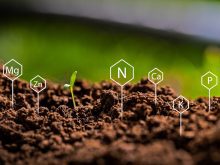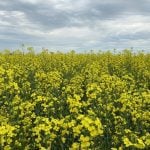There is perhaps no bigger challenge for an agronomist than having a tough but frank conversation with a farmer client.
You won’t get any argument on that count from Ron Tone. He founded Tone Ag Consulting in 1996, following a 17-year career as a farmer. His independent agricultural consulting firm specializes in damage claims, crop scouting and manure management, and works with dozens of clients throughout Manitoba.
Tone was one of the featured speakers at the 2024 Manitoba Agronomists Conference, held Dec. 11 and 12 in Winnipeg. Fittingly, the theme of his presentation was tough conversations to have with farmers and how both new and seasoned agronomists can best handle those difficult discussions.
Read Also

Claas brings 1000 Series SP forage harvesters to Canada
In mid-August, Claas unveiled its new line of Jaguar forage harvesters at an event in Visalia, California, deep in the heart of that state’s dairy region.
Tone recalled one particularly challenging conversation he had with a client 10 years ago. The farmer had filed an insurance claim alleging his flax crop was damaged by drift from glyphosate sprayed on a neighbouring farm.
Tone visited the farm to gather information for the insurance claim. There he met with the owner and the neighbouring farmer and patiently listened to what both sides had to say.
While the two farmers were friendly toward each other when they were together, each had a much different take on the situation when Tone spoke with them separately. That’s why he recommends agronomists speak with both parties independently when dealing with insurance claims and spend some time analyzing the data they gather before making a recommendation to the insurance company.
“I go and take that information and usually sit down and think about it for a while after I’ve seen the claim, go over the two responses and then try and make a decision,” he said, adding he and staff will usually review things, such as wind speed and direction, before rendering a decision.
“The lesson there is (it’s best) to talk to them separately.”

Tone started his career in agriculture working as a representative for an agricultural company in Ghana, West Africa, for three years. He returned home to Manitoba after that to operate his own farm near St. Pierre-Jolys but decided to get out of the business in the 1980s when interest rates started to skyrocket.
A career in agronomy had always been in the back of his mind. He decided the time was right to pursue it since there weren’t many sources of independent advice available to farmers in the area.
Tone said one of the biggest challenges for him when he was starting was understanding how to build relationships with farmers with whom he had no prior contact.
“At first I didn’t realize how important it was,” he said.
“I thought, well, I’m coming in with all this information. My head (was) nice and big. I thought, ‘I can tell the farmers here what to do now and how they should be doing it.’” But over the years, he realized it’s important to build and strengthen relationships with each farmer “because as you get growing with confidence in what you’re doing he’s going to listen to you more and more.”

A key part of building those relationships, Tone said, is earning the trust of the client and developing a two-way dialogue with them. “That’s where you build your relationship.”
As farmers get to know you, they trust you, and you can tell them what you need to, he said.
“I’m always careful about doing that, going in and (right) off the bat telling them, ‘This is what you should be doing.’ By understanding your client, you can get an idea how far you can go in these things because you can turn them off pretty fast… if you start coming in with a big head like you know everything.”
Tone recalled how he put thousands of kilometres on his truck during the first couple of years after starting his business. When he wasn’t meeting potential clients at their farms, he was attending community meetings and ag shows where he got to know people and explain how he could help make their operations more efficient and profitable.

Those face-to-face meetings and the word of mouth they generated played an essential role in helping him build the business.
“The approach that I usually use (with clients) is to say just how much can you do on your farm. I’m basically here supplying an extra set of eyes,” he said.
“Yes, in some years where there is no crop disease or very little or the farmer already has his plans, he’s going to spray regardless in his canola and beans so he doesn’t really need a crop scout.”
But in tough years, when, for example, “weeds start coming in,” agronomists can help, he said. “We go out there on a weekly basis to make sure things are growing well and if the chemical didn’t work, we see that right away.”
One of the toughest conversations for an agronomist to have with a farmer can be when they are asked why they should pay for their services when the local ag retailer input company can provide the same thing for free.
Tone’s advice to fellow agronomists is to highlight exactly what kind of services they provide to clients and how they differ from those provided by input companies.
“I basically lay out the different things we do: coming out once a week and then giving them a report, showing them what I saw out there, plant populations, how the crops are doing, what we’re following up with after spraying is done,” he said.
“There’s a whole list of things I go through to show them what we do. We’re going across the field. We’re not just going and stopping the pickup truck on the edge of the field and walking in 50 yards or whatever and saying this is what you need… in that part, but the rest of the field is great.”
Again, Tone said it all comes back to relationship building and that’s something that doesn’t happen overnight.
“There’s (got to be) patience there too. I would say I used to be a person who would jump out and get upset and angry about things,” he said. “I’ve learned over the years that it’s probably not the best thing to do. Patience pays off and (helps build)… a relationship where they can see you’re somebody they feel they can work with.”
The same advice holds for agronomists working with producer organizations, Tone said. Tone has first-hand experience with that. He played a key role in helping the Manitoba Pulse and Soybean Growers develop the On-Farm Network in 2014. The network conducts research on new products and practices to provide growers with answers to an assortment of production-related questions including disease-fighting tools and fertility treatments.
Tone said the inspiration for the network was that provincial and federal governments were cutting back on the funding they were providing for research at the time, and pulse and soybean producers didn’t know where to turn to get answers on subjects such as how much inoculant to use and the best time to apply it.
One of the toughest conversations an independent agronomist can have is often with themselves: When do I want to retire and what kind of transition plan do I want to put in place for the business?
Tone found himself in that spot about eight years ago. He was looking to cut back his workload and was interested in selling off a majority interest in the business. Luckily, two of his employees made an offer to buy the business and he now works for them.
“They took over and it’s been quite a neat transition.”
















